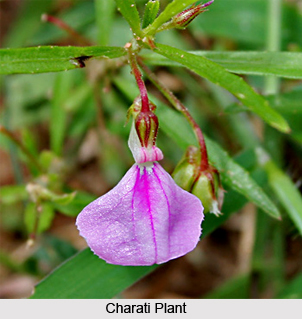 Charati is an Indian medicinal plant that is known for its huge curative properties. Scientific name of this medicinal plant is Hybanthus enneaspermus. It is also known by several other names in different languages. Charati is a Sanskrit term. Another name of this plant in Sanskrit language is padmacarini. Like for instance, in Bengali language, Charati is called as nunbora; in Hindi language it is known by the name of ratanpurus. Further, in Malayalam language this medicinal plant is called kalthamara and orelatharmara. In Tamil language it is called as orilaitamarai and purusharatnam; and lastly in Telegu language, Charati is known by nilako-bari, purusharatanam and suriyakanti. Charati is found throughout the old world tropics and subtropics. In India this plant occurs mainly in Uttar Pradesh, West Bengal and in southwards in Tamil Nadu and Kerala.
Charati is an Indian medicinal plant that is known for its huge curative properties. Scientific name of this medicinal plant is Hybanthus enneaspermus. It is also known by several other names in different languages. Charati is a Sanskrit term. Another name of this plant in Sanskrit language is padmacarini. Like for instance, in Bengali language, Charati is called as nunbora; in Hindi language it is known by the name of ratanpurus. Further, in Malayalam language this medicinal plant is called kalthamara and orelatharmara. In Tamil language it is called as orilaitamarai and purusharatnam; and lastly in Telegu language, Charati is known by nilako-bari, purusharatanam and suriyakanti. Charati is found throughout the old world tropics and subtropics. In India this plant occurs mainly in Uttar Pradesh, West Bengal and in southwards in Tamil Nadu and Kerala.
Charati is basically a small perennial herb around 15 cm to 30 cm tall with a woody base and numerous diffuse or ascending branches. Its leaves are sub sessile, linear to oblanceolate, near about 4 to 5 cm long and about 0.2 to 0.8 cm wide, and its margins are serrate; stipules gland-tipped and subulate. Flowers of this medicinal plant are solitary, axillary, generally red or purple in colour, with 6 to 12 mm long, slender and erect pedicels, it has small bracts above the middle of the pedicel; with 2.5 mm long, lanceolate, very acute and keeled sepals; its petals are unequal, the upper two are oblong, and the lateral two falcate, whereas the lowest one is much larger than the others with an orbicular or obovate limb with a long claw which is curved behind into a short spur. Its fruits resemble a small sub-globose capsule around 0.6 cm in diameter; with ovoid seeds, generally yellowish-white in colour and around 1.5 mm long.
Charati has several medicinal properties and is vastly used for remedial purposes in the country. The whole plant is considered to possess tonic, diuretic and demulcent properties. The leaves and tender stalks are demulcent and are used as a decoction or electuary; with oil, they are used to prepare a cooling liniment for the head. The dried powdered leaves are used to treat asthma. The root is diuretic and administered as an infusion to treat gonorrhoea and urinary infections; it is also used to treat bowel complaints in children among the Santhals. The fruit of Charati plant is reportedly used in combination with other plant drugs to treat scorpion stings.



















